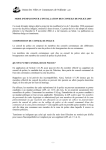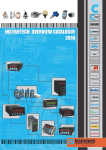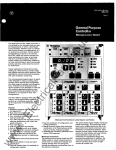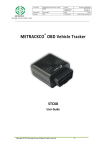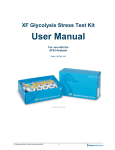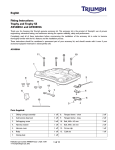Download Analogger Manual.cdr
Transcript
The Cycle Analogger User Manual Revision 1.0 0.599453.150.110.004.6239 0.599453.150.110.004.6239 0.599453.150.110.004.6239 0.599453.150.110.004.6239 0.599950.1010.110.004.6239 0.600550.1010.110.004.6239 0.601150.1010.110.004.6239 0.601650.1010.110.004.6239 0.602549.4015.310.004.6239 0.603349.4015.310.004.6239 0.604249.4015.317.104.6243 0.605049.4015.317.104.6246 0.606048.5017.257.104.6250 0.606948.5017.257.104.6254 0.607948.5017.2510.494.6260 0.608948.5017.2510.494.6266 0.608953.020.4310.494.6272 0.608953.020.4310.494.6278 0.608953.020.4310.644.6284 0.609053.020.4310.644.6289 0.609152.283.1510.644.6295 0.609352.283.1510.644.6301 0.609552.283.1511.304.6308 The Cycle Analogger, Rev 1.0 The Cycle Analogger is designed and manufactured in Canada by: Grin Technologies Ltd. 20 E 4th Ave Vancouver, BC, Canada V5T 1E8 ph: (604) 569-0902 email: [email protected] web: http://www.ebikes.ca Authors: Mark Stephens Justin Lemire-Elmore Copyright © 2012 1 Table of Contents 1. Introduction . . . . . . . . . . . . . . . . . . . . . . . . 3 2. Installation . . . . . . . . . . . . . . . . . . . . . . . . . 3 ...................3 ....................4 2.1 Electrical Wiring. . . . . 2.2 Mechanical Installation. 3. Basic Usage . . . . . . . . . . . . . . . . . . . . . . . ..... ..... ..... . . . . 5 5 6 6 Advanced Features . . . . . . . . . . . . . . . . . . . . . . 7 7 7 8 8 3.1 Data Saving . . . . . . . . . . . . . . . . . . . . 3.2 LED Status Indicator . . . . . . . . . . . . . . . 3.3 Data Retrieving . . . . . . . . . . . . . . . . . . 4. . . . . 4.1 File Naming Conventions. . . . . . . . . . . . . . 4.2 Analog & Thermistor Inputs . . . . . . . . . . . . . . 4.3 Use as a General Purpose Logging Device . . . . 4.4 Firmware Updates . . . . . . . . . . . . . . . . . . . . 5. 5.1 5.2 5.3 5.4 5.5 Limitations. . . . . . . . . . . . . . . . . . . . . . . . . 9 Card Insertion . . . . . . . . . . . . . . . . . . . . . . . . 9 Card Vibration . . . . . . . . . . . . . . . . . . . . . . . . 9 Exposure . . . . . . . . . . . . . . . . . . . . . . . . . 9 GPS Locking . . . . . . . . . . . . . . . . . . . . . . . . 9 Battery Replacement . . . . . . . . . . . . . . . . . . . . 10 6. Specifications . . . . . . . . . . . . . . . . . . . . . . . . 10 7. APPENDIX A: Settings.txt file . . . . . . . . . .11 8. APPENDIX B: Analog Input Pins. . . . . . . . . 13 2 1. Introduction The Cycle Analogger is a compact storage device designed to take the data output stream from a Cycle Analyst and record it on a microSD flash memory card, allowing for post-trip analysis of a vehicle's power consumption and performance data. The optional GPS version includes a built-in Global Positioning receiver that simultaneously stores the vehicle's position information to the memory card as well. This makes it possible to localize the Cycle Analyst's output to a certain point on the trip and visualize the vehicle statistics in a mapping program such as Google Earth. 2. Installation 2.1 Electrical Wiring If the Analogger device is purchased at the same time as the Cycle Analyst (CA), then we will have pre-wired the CA to include both a communications cable and a DC power plug for connecting to the Analogger. This allows for the two devices to plug straight into each other with no additional wiring or soldering required. TRS Signal Cable DC Power The Analogger in this arrangement receives power directly from the vehicle's battery pack via the Cycle Analyst, and hence will turn on and off when the CA is turned on and off. If the Cycle Analyst is not already wired for Analogger connection, then it will be necessary to open up the CA's enclosure and solder the included TRS (Tip Ring Sleeve) cable jack to the appropriate points. 3 All CA devices since firmware V2.1 have a serial data stream on a pad labeled Tx. The ring (red wire) must be soldered to the Tx pad, while the sleeve (black wire) attaches to a G pad. Solder : Red to Tx Black to G The DC power for the Analogger may be supplied from the battery pack via the Cycle Analyst, or it can be hooked up to the battery or other 12-100V power supply through any other means as well. The DC power input is a 5.5 x 2.1mm power jack, and it will be ground referenced to the Cycle Analyst ground. The Analogger has an efficient onboard DC-DC converter, so the current consumption is not constant but will vary inversely with the supply voltage. Analogger Current Draw 35 30 Current (mA) + - - + 12V-100V Analogger, No GPS 25 Analogger plus GPS 20 15 10 5 0 0 50 100 Voltage 2.2 Mechanical Installation The Analogger circuit fits inside a compact enclosure with flanges on the lid to allow for mounting versatility if required. It is also small and light enough to easily tuck inside a pocket or handlebar/frame bag. 80mm 40mm 20mm The unit itself is not waterproof, and so provision should be taken when riding in the elements to keep the Analogger protected against water exposure. 4 3. Basic Usage 3.1 Data Saving The Analogger has a 3 position sliding switch to control operation. The center switch location is OFF. The device is turned on in Logging mode by moving the switch to the right, towards the signal port. In this state, the Analogger will create a new log file on the microSD memory card and begin recording any serial data coming from the communications port to this file. The data will continue to be saved to the card until either the switch is moved back to center position, or power is removed from the Analogger. Signal from Cyce Analyst Switch to Right for Data Logging By default, the Cycle Analyst file will be named CAlog_XXXX, where the number XXXX will increment with each new file, and will contain the text like this: Ah 0.1920 0.1962 0.2004 0.2046 V 52.79 49.30 49.12 49.04 A 5.19 18.89 18.85 19.02 S 17.27 18.00 20.60 21.88 D 1.9644 1.9682 1.9725 1.9773 With a GPS module attached, the GPS data will get saved at the same time to a separate file named GPSlog_XXXX, with NMEA formatting. Details on each sentence can be found from the published NMEA standard. An example GPS file text is shown here: $GPGGA,013449.000,4916.6569,N,12306.0222,W,1,08,1.1,21.0,M, -16.8,M,,0000*5E $GPGLL,4916.6569,N,12306.0222,W,013449.000,A,A*42 $GPGSA,A,3,04,27,02,14,09,12,20,17,,,,,2.2,1.1,1.9*32 $GPGSV,3,1,12,09,56,240,27,04,55,121,33,27,51,217,27,12,42,297,29*75 $GPGSV,3,2,12,17,40,062,36,02,32,177,35,14,12,320,34,20,09,044,18*7E $GPGSV,3,3,12,25,07,295,23,28,06,111,39,32,03,020,,51,31,159,28*73 $GPRMC,013449.000,A,4916.6569,N,12306.0222,W,0.00,,090711,,,A*65 $GPVTG,,T,,M,0.00,N,0.0,K,A*13 5 3.2 LED Status Indicator There are 2 or 3 LEDs on the device to indicate operational status: GPS Status LED SD Card LED Power LED Power LED: Glows steady red when an appropriate power source ? is present. SD Card LED: The green LED will blink at each instance that data ? is being succesfully written to the memory card. This provides feedback that data is being logged correctly. GPS LED: If the GPS module is included, a 3rd LED indicates the ? GPS status. A fast flash rate of 5 Hz indicates that the GPS is on but has not yet acquired a satellite location fix. Once a location fix has been confirmed, then the LED will flash at a much slower 1 Hz. 3.3 Data Retrieving There are two methods for retrieving data stored on the Analogger: a) Remove the microSD memory card by pushing it with your finger to release the latch and then access the files with a card reader, or b) Flip the switch to the left, towards the USB port, and connect a USB Mini-B cable between the Analogger module and a computer. Removable SD Memory Card To PC USB Port USB Mini Cable 6 Switch to Left Position for USB In the USB state, the Analogger behaves as a USB mass storage device enabling you to access the files as though they were on a removable drive without the need for a card reader. External power is not required as the unit will be energized by the USB bus. Once connected to a PC, the files can be opened in a text viewer, spreadsheet, or processed with custom software. 4. Advanced Features There are many capabilities built into the Analogger design which can facilitate more advanced data logging applications. 4.1 File Naming Conventions There is a setup.txt file located in the root drive of the SD memory card that can be used to customize the file names. This makes it easier for people with multiple Analogger devices to better keep track of which files originated from which vehicle. As well, if there is a valid GPS signal detected during the course of a save, the Analogger will append a complete time stamp to the end of the file name making it much easier to relate the files to particular trips. The details for customizing the file name are given in APPENDIX A. 4.2 Analog and Thermistor Inputs The Analogger circuit board has two input pads that can be used for saving voltage data from additional signals as well. This way, it is possible to simultaneously log additional sensor data along with the CA information, such as the user's throttle voltage, motor or controller temperature, vehicle incline, air pressure, or what have you. Each of the analog pads can be configured as a general purpose 03.3V input, or as a direct 10K NTC thermistor input for temperature sensing. Use of these analog inputs requires soldering wires to the circuit board and modifying the enclosure to feed the wires through, and hence requires being comfortable with electronics hacking. 7 General Purpose Voltage Signal Vi + - R8 and R9 Pullups. Remove if Necessary 10K NTC Thermistor Soldering Required If analog data is enabled, it will be saved in a separate data file on the card named ADClog_xxxx. A full explanation of the analog input functionality and appropriate configuration is given in APPENDIX B. 4.3 Use as a General Purpose Logging Device Although the Analogger was designed around the specific needs of the Cycle Analyst, it can be easily used to log serial data from other instruments with a 9600 baud output as well. For instance, you could in principle get the regular (non-GPS) version of the Cycle Analogger and still record the data from a 3rd party GPS device with a TTL output by soldering wires to the header pad where the onboard GPS module would normally attach. 4.4 Firmware Updates It is possible to reprogram the Analogger device with the most recent firmware via the USB port. This way the device can be kept current with the most recent functionality and possible bug fixes. Some 3rd party downloads are required, and the full reprogramming details are explained in a separate document available from the ebikes.ca webpage. 8 5.0 Limitations 5.1 Card Insertion The insertion and removal of the small microSD memory card can be finicky. For removal, press the back of the card in and it will release a latch causing the card to pop out. When re-inserting the card, be sure to make sure that it is properly slid inside the card carrier and not pushed in the gap above. The card opening in the enclosure had to be wider than the card to allow for easier finger access, but it means that it does not necessarily guide the card properly into place. Avoid Pushing Card Into Gap 5.2 Card Vibration In cases where the Analogger is used in rough and bumpy terrain, it's possible for the heavy vibration to cause intermittent contacts and lead to corruption in the data logging. We recommend in this situation to have the Analogger in a padded bag or pannier for better shielding from shock. 5.3 Exposure Because this is a small run device, it uses a modified off-the-shelf enclosure which gives mechanical protection to the circuit board but not full environmental protection against the elements. For use on long touring trips or exposure to all kinds of conditions, we recommend further placing the Analogger in a plastic bag or sealed container. 5.4 GPS Locking When the GPS device is first powered up, it can take anywhere from 30-120 seconds before it will correctly lock to the satellite location. Once it has found a fix, an onboard backup battery maintains the location data so that if it is turned off and on in the same location, then a new GPS fix will usually take just a few seconds. In locations with limited sky visibility (between tall buildings, tunnels, forest etc), the GPS receiver may have difficulty locking to the satellites and the GPS status LED will indicate this with a rapid 5Hz flash rate. 9 5.5 Battery Replacement The coin cell in the GPS version of the Cycle Analogger is used to maintain GPS coordinate information even when device power is turned off. Without a good battery installed the GPS functionality will not work properly. The supplied cell should last between 3-5 years from the date of purchase, and can be replaced with any similar CR2032 cell. 6.0 Specifications Supply Voltage 12V - 100V DC Max Supply Power 200 mW with no GPS, 450 mW with GPS UART Input Signal 0-3.3V or 0-5V TTL, 9600 Baud Analog Input Range 0-3.3V Flash Memory Type microSD or microSDHC Memory Capacity Up to 32 GB (1GB card included) Dimensions 80 x 40 x 20mm 10 APPENDIX A: The settings.txt file Various parameters of the Analogger's operation can be controlled with a text file that is stored in the root directory of the memory card. If the Analogger does not detect a settings.txt file on power up, or the included file is corrupted, then it will proceed to create one with default values. The following are the list of default parameters along with their allowable values shown in square parentheses: a0: a1: a2: b1: b2: f0: f1: f2: f3: t0: t1: Off [On, Off] B [B,V,C,F] (note: B = binary, V = voltage, B [B,V,C,F] C = Celsius, F = Fahrenheit) 3977 [0 to 9999] 3977 [0 to 9999] 0000 [0 to 9999] "CAlog_" "GPSlog_" "ADClog_" Off [On, Off] GMT -08:00 [GMT-12:00 to GMT+13:00] The a0 term dictates whether or not analog logging is enabled. To record the analog inputs, this must be set to "On" The a1 and a2 parameters determine how the analog data is saved, while b1 and b2 indicate the thermistor Beta constant for temperature calculations should one of the temperature modes be selected. For instance, if the A1 pad is wired to a thermistor with Beta constant of 3800, while the A2 pad is measuring a throttle voltage, then the file would be modified with the following text: a0: a1: a2: b1: On C V 3800 The resulting log file for analog data would then display two columns, with the first column formatted in degrees Celsius, and the second formatting as 0-3.3V: A1 33.4 33.6 33.5 A2 1.12 1.33 1.59 .. .. If instead we wanted the results to be saved in degrees Fahrenheit and with the throttle voltage showing as a number from 0-1023 rather than as a voltage value, then we would set: 11 a0: a1: a2: b1: On F B 3800 In which case the same signals would save as: A1 92.1 92.5 92.3 .. A2 347 412 493 .. f0 is the counter index and it is incremented each time a new set of log files is created. The first file will save as CAlog_0000.txt, the next will save as CAlog_0001.txt, etc. This counter index can be preloaded to any value or reset to zero by manually changing the number at f0. The counter value will be appended to all data files saved, so if both the GPS module and the analog files are enabled, they will also share the same counter number as the CA log file. The text string following each of the f1, f2, and f3 parameters allows for the customization of the prefix for each file name. This is especially useful if someone has multiple Analogger devices to avoid creating log files with identical names. The string must be enclosed in double quotes, must be less than 200 characters long, and should only contain valid file name characters. Finally, t0 and t1 are the time stamp parameters and only apply if a GPS module is enabled. In that case, the current time and date as supplied from the GPS will be appended to each file name for easier identification and sorting. In order to apply an hourly offset to account for a local time zone or daylight savings, then the t0 parameter should be switched to On and t1 should be set to the local time zone. For instance, a rider in New York (Eastern Time Zone, GMT-5) would use: t0: On [On, Off] t1: GMT -05:00 [GMT-12:00 to GMT+13:00] In the summer, during daylight savings, this would be: t1: GMT -04:00 [GMT-12:00 to GMT+13:00] A rider in France would use GMT+01:00, New Zealand would be GMT+12:00. And indeed our friends in Newfoundland can use GMT03:30 for the half hour offset. 12 APPENDIX B: Analog Input Pads Enabling the ADC: The analog input functionality is turned ON by setting the a0 parameter to On in settings.txt file. Once the analog function is enabled, then the CA will save the voltage data present on pads A1 and A2 to a text file just like the Cycle Analyst data. The timing of each voltage measurement is triggered by the arrival of a new line of data from the Cycle Analyst, so the analog data will get saved at either 1Hz or 5Hz depending on the CA's data output rate. If a Cycle Analyst is not connected, then no analog data will be recorded either. Analog Circuit The default input circuitry has both pads A1 and A2 connected with 1K pull-up resistors (R8 and R9) to a 3.3V bus. This makes it easy to hook up a probe for temperature sensing by wiring a 10K NTC thermistor between the A1 or A2 pad and AGND. The combination of a 1K pullup resistor with a 10K thermistor provides good resolution from 0 to about 160 Celsius. 3.3V 10K NTC Thermistors 3.3V R8 1k Signals V1 and V2 , Scaled 0-3.3V if needed R9 1k V1 + - A1 AGND A2 AGND V2 + Example Wiring for Two Temperature Probes R8 removed R9 removed A1 AGND A2 AGND Example Wiring for Two Voltage Signals If an active voltage signal is being measured, then it would be advisable to remove the associated 1K pull-up resistor on that channel. Voltage signals that could exceed 3.3V should have an external voltage divider to scale the signal down to the 0-3.3V input range. All voltage signals are measured relative to the same ground as the Analogger and Cycle Analyst. 13 Analog Formatting The reading from the analog pads can saved into one of four possible formats via the settings.txt file. These options are: "B" = Binary, a 10 bit integer from 0-1023 "V" = Voltage, the direct voltage value from 0.00 to 3.30V "C" = Celsius, scales a 10K thermistor into degrees C "F" = Fahrenheit, scales a 10K thermistor into degrees F When either of the temperature options are chosen, then the Analogger does a computation of the temperature based on the Beta constant for the thermistor, and records the data directly in degrees. The user can set the appropriate Beta value in the settings.txt file, the default value being 3970. 14
















